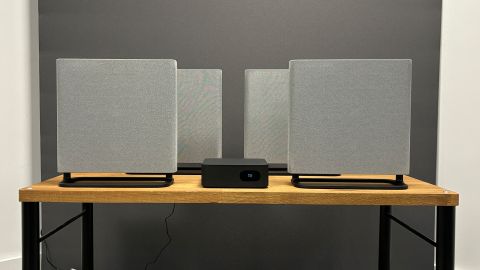While we firmly believe that a dedicated AV receiver and speaker package is the best way to achieve immersive home cinema sound, we also have to admit that there are some compromises to be had in opting for a set-up such as that. Let’s not beat around the bush – whether for practical or aesthetic reasons, no one wants cables trailing around their living room. Rogue wires usually repulse interior design aficionados, while cats and dogs often like to gnaw at them.
That's why a product such as the Sony Bravia Theatre Quad makes total sense to us – it’s a full surround-sound speaker package that is wireless except for the power cable for each unit, with sound being sent through the air from a box hooked up to your TV’s HDMI eARC socket. Conceptually, this neat solution is already a winner. Sony has attempted this type of product before with incredibly successful results: the HT-A9 has been a beloved product within What Hi-Fi?’s Team AV so news of a sequel has us rather giddy.
Price

Unfortunately, the Bravia Theatre Quad system takes a bit of a stumble at the first hurdle, as it is significantly more expensive than the preceding HT-A9 package. At £2499 / $2499 / AU$3699, the Quad is a whopping £1000 / $700 / AU$1200 pricier than its predecessor.
The HT-A9 launched at £1599 / $1799 / AU$2499 back in 2021, and while we have to acknowledge that inflation and the financial landscape have changed drastically within the last three years, this still feels like a rather excessive and gratuitous leap in price. While the Quad is set to succeed the HT-A9 in the long term, the older model remains available on Sony’s website and through other retailers, although we’re not sure for how long that will be the case.
Furthermore, as was the case with the HT-A9 system Sony doesn’t include a subwoofer with the Quad, so you’ll have to shell out even more cash for either the SA-SW5 or SA-SW3 if you feel like the low end is lacking – more on that later.
The Quad system also looks very expensive next to our favourite soundbar-based speaker system, the Samsung Q990D, which includes a soundbar, two wireless surrounds and a wireless subwoofer for £1699 / $1400 / AU$1999.
In fact, the Quad's price isn't far off that of an entry-level AVR and surround speaker package – though we're well aware that such a system isn't an option for those looking to cut cords from their living room.
Build
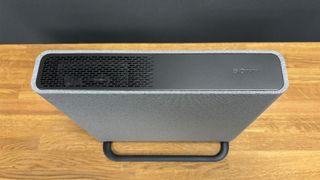
This wireless speaker system has gone through a dramatic physical transformation since its previous iteration. The HT-A9 system featured four cylindrical speaker units, whereas the Quads are a quartet of flattened square speakers that can either sit on the minimal included stands or be wall-mounted with the included brackets. Sony has cleverly implemented the power connection on the bottom edge of each speaker with a small cable guide that ensures the single wire doesn’t detract from the sleek and understated styling. Each speaker measures 31 x 29 x 13cm (hwd) with the tabletop stands applied, which means that they are an identical height to the HT-A9 speakers.
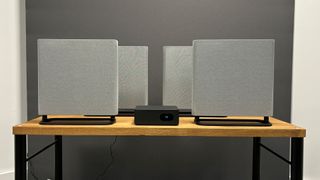
Connections 1 x eARC, 1 x HDMI input
Video pass-through 4K/120Hz, HDR10, Dolby Vision, HLG, ALLM, VRR
Chromecast? No
Apple AirPlay 2? Yes
Bluetooth 5.2
Voice control Works with Google Assistant and Amazon Alexa
Audio formats Dolby Digital, Dolby Digital Plus, Dolby TrueHD, Dolby Atmos, Dolby Dual mono, DTS, DTS HD High-Resolution Audio, DTS HD Master Audio, DTS ES, DTS 96/24, DTS:X, LPCM
Dimensions (hwd) Speakers: 31 x 29 x 13cm, control hub: 5.6 x 16 x 16cm
Speaker weight 2.6kg
Much like the HT-A9, the Quad is available in just one colour – a mild and inoffensive if slightly drab grey. While this colour should blend well with most home interiors, we think a handful of colour options would have been a nice touch to really help integrate these speakers into a variety of different home designs. Unfortunately, the speakers don’t match the optional subwoofers in Sony’s range, so if you plan on adding one of those, be prepared for a mismatched aesthetic.
While the speakers themselves have had a drastic redesign, the connectivity hub box that controls this system has not, although it is slightly larger this time. It’s still a rounded black box that can easily be confused for an Apple TV 4K streamer at a glance, with a small display on the right-hand side that occasionally displays information such as your input or if the speakers are in pairing mode. The control box has a fairly understated footprint, at just 5.6 x 16 x 16cm (hwd), making it discreet and easy to neatly tuck away in a media unit.
Features
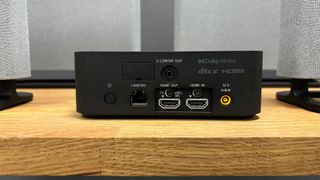
The Bravia Theatre Quads are a clear step up over the HT-A9 in the specification department, and that’s evident from the sheer number of drivers. There are 16 channels with a total power output of 504W. There are four speakers in each unit – a forward-firing X-Balanced woofer, midrange driver and tweeter, and an up-firing X-Balanced driver. X-Balanced drivers, for anyone wondering, are developed by Sony to deliver 'a powerful, spacious sound and a more rewarding listening experience' and can be found in various Sony portable speakers and Sony soundbars.
Comparatively, the HT-A9 speaker system features 12 speakers in total, so the Bravia Quads take the crown here. However, more speaker units don't necessarily mean better sound, but we’ll come to that in due course.
Setting up the Quad system is an absolute breeze: simply clip together and screw in the included stands (or wall mounts), plug each speaker into a wall socket and hook the control box up to your TV with the included HDMI cable. From here the Bravia Connect app does much of the heavy lifting, which is appreciated as there is no on-TV set-up process – something that the HT-A9 did have.
The new Bravia Connect app (with which the HT-A9 is not compatible, in case you're wondering) picks up the slack, however, and it does so with an intuitive and easy-to-navigate interface. The step-by-step instructions tell us how to position the speakers, allow us to connect the system to the wi-fi, and take us onto the auto-calibration system – a necessary step for a product such as this, as placement can seriously affect the sound. Sony accounts for this with a handy calibration system using the microphone in our mobile phone. It asks us to hold the phone in the ideal seating position and to direct our handset towards the TV to better hone the sound and accommodate Sony’s 'sound from the screen' philosophy. This also contributes towards the Sound Field mode, which we will dig further into during the sound portion of this review.
As for sound format support, the Bravia Theatre Quad includes the expected duo of Dolby Atmos and DTS:X, as well as Sony’s 360 Reality Audio immersive format. Connectivity also gets a boost, with AirPlay 2, Spotify Connect and Bluetooth 5.2 in the SBC, AAC and LDAC codecs. Furthermore, wired connectivity is solid with a single full bandwidth HDMI 2.1 passthrough socket on the control box. It supports 4K/120Hz signals with VRR and ALLM; this is hugely appreciated as many TVs (even Sony’s latest and greatest Bravia models) are still limited to just two HDMI 2.1 ports, so claiming one back for your PS5, Xbox Series X or gaming PC is a thoughtful touch. That HDMI socket also supports Dolby Vision HDR and HLG.
Finally, there are a handful of features that promote synergy with Sony TVs. Acoustic Centre Sync is included here, which will incorporate the speakers in a supported Sony TV and which the company says will deliver fuller-sounding vocals and better match effects to their position on the screen. There is also a handy quick settings menu, and the Voice Zoom 3 feature that boosts dialogue to make it clearer in scenes with lots of additional sound effects.
There is also a simple, lightweight remote in the box that features all of the basic buttons we need to operate the system. While it may seem like a step back from the HT-A9’s button-heavy controller, the Bravia Connect app is more fully featured.
Sound
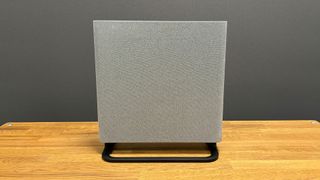
While home cinema purists will probably turn their noses up at a wireless speaker system, citing that compromising audio quality for the sake of convenience is a futile effort, we’re here to defend the Bravia Quad, as this system sounds rather good. We’ll get the disclaimers out of the way first regarding the wireless aspect: during our testing time, we didn’t come across any lag, dropouts or desynchronised audio.
We have also paired the Quads with the Sonly A80L OLED TV for our testing, which has given us access to the Bravia-centric features including Centre Sync. We’re overall very pleased with this feature, as it provides a convincing sound-from-the-screen effect while also ensuring the TV speakers and the Quads sound cohesive. We expect the performance to vary based on the TV you’re using here, though; for instance, we suspect that the A95L might sound even better with its impressive sound system, while some of Sony’s LCD TVs could sound different due to the fact they don’t have the actuator based system found on the OLEDs.
Onto the main event, how does the Bravia Theatre Quad system sound? In many ways, this is a truly impressive product. We’d describe these speakers as clean, crisp and energetic, as they deliver a really engaging and clear sound. Testing them with a variety of our go-to test discs, including Blade Runner 2049, Top Gun: Maverick, The Batman, Unbroken and Dune: Part 2, we’re pleased with how crisp and detailed dialogue is, and that applies to general sound effects too. Low-level dynamics are also well-presented, with an earnest monologue during the final scene of The Batman being skillfully handled with plenty of tangible emotion to be felt throughout.
It’s also a mighty fine performer when it comes to Dolby Atmos height effects, as well as placing sounds around our seating position. Using Unbroken as our Dolby Atmos test disc, we’re treated to an immersive performance that surrounds us in a bubble of sound. We toggle the Sound Field mode on and off to test how it impacts immersive audio, and it leads us to a simple conclusion: Sound Field creates a bigger and broader sound with a greater emphasis on height effects, although it loses some focus in the process. That being said, we found the tradeoff of scale for a slight sacrifice in precision to be worthwhile overall.
Blade Runner 2049 provides further proof that these speakers are truly skilled at creating a sense of space and placing object-based sound. The 'baseline' interview scene in chapter two is a prime example, with the interviewer’s voice truly feeling like it is being projected from a ceiling speaker. Furthermore, in the scene in which Officer K returns home to his apartment and speaks to Joi from what appears to be another room, the Quad system does an excellent job of recreating the area and placing the sounds to simulate the effect of characters speaking in different rooms.
Cohesion is also a key strength, as the speakers all work harmoniously and there are no noticeable gaps between each unit. This is most likely due to each speaker having the same driver configuration, and it works to the system’s strength greatly.
However, there is one notable shortcoming with the Bravia Quad: unfortunately, there's just not enough weight or depth to the bass, particularly given the price of the system. Returning to Blade Runner 2049’s tricky chapter two sequence, the Flight to LAPD track is just lacking some oomph, leaving it feeling lightweight and therefore impacting the tension of the sequence. While it’s not necessarily dynamically challenged – in fact the building volume helps to add a sprinkle of tension into the scene – it’s purely the bass that feels hollow.
Comparing the Quad to the HT-A9, we find that this newer model is a step up in a variety of ways – clarity, crispness and spatial effects particularly – but it just isn’t quite as punchy and solid when it comes to low-end effects. Truthfully, we’d pair the A9 system with a subwoofer if given the opportunity, but it doesn’t feel essential; the Quad, on the other hand, feels like it really needs a subwoofer in order to flourish.
While that wouldn’t necessarily be an issue, we have to remember that this system is notably more expensive than the previous model, so shelling out additional cash for one of Sony’s optional wireless subwoofers feels like a bigger sting. For the money, we would have liked to have seen a subwoofer bundled in with the system.
Verdict
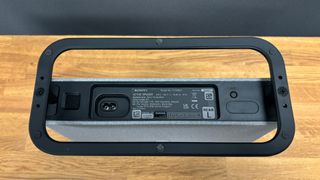
Calling a verdict on the Sony Bravia Theatre Quad is tricky. There are very few systems that can rival it for convenience, and it is a step up over its predecessor in many ways. However, it’s just too expensive to wholeheartedly recommend, especially when getting the very best out of it involves shelling out extra for a subwoofer.
Still, if you want a discreet and fairly stylish sound system that’s especially good at Dolby Atmos height effects, then this could be an ideal option for you. Even more so if you're already the owner of a compatible Sony TV.
SCORES
- Sound 4
- Build 4
- Features 5
MORE:
Read our review of the Sony HT-A9
Also consider the Sennheiser Ambeo Max
Read our Sonos Arc review
Best soundbars: options for every budget, recommended by our experts
